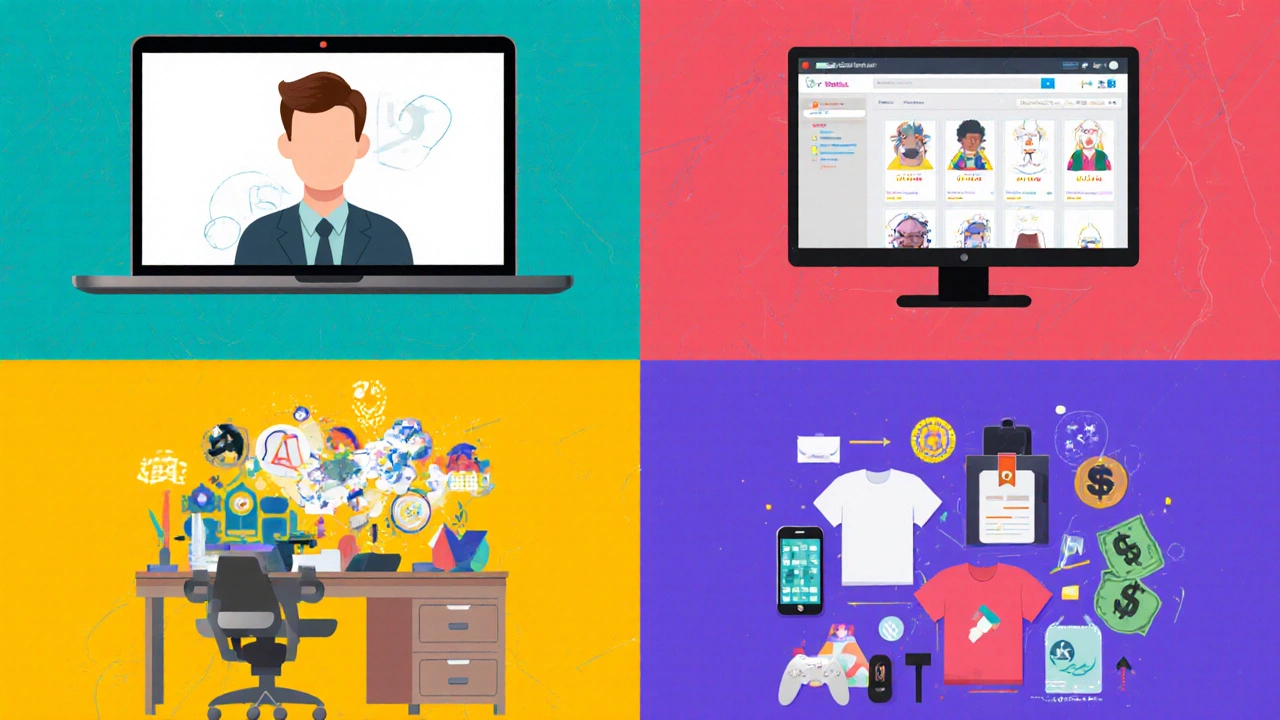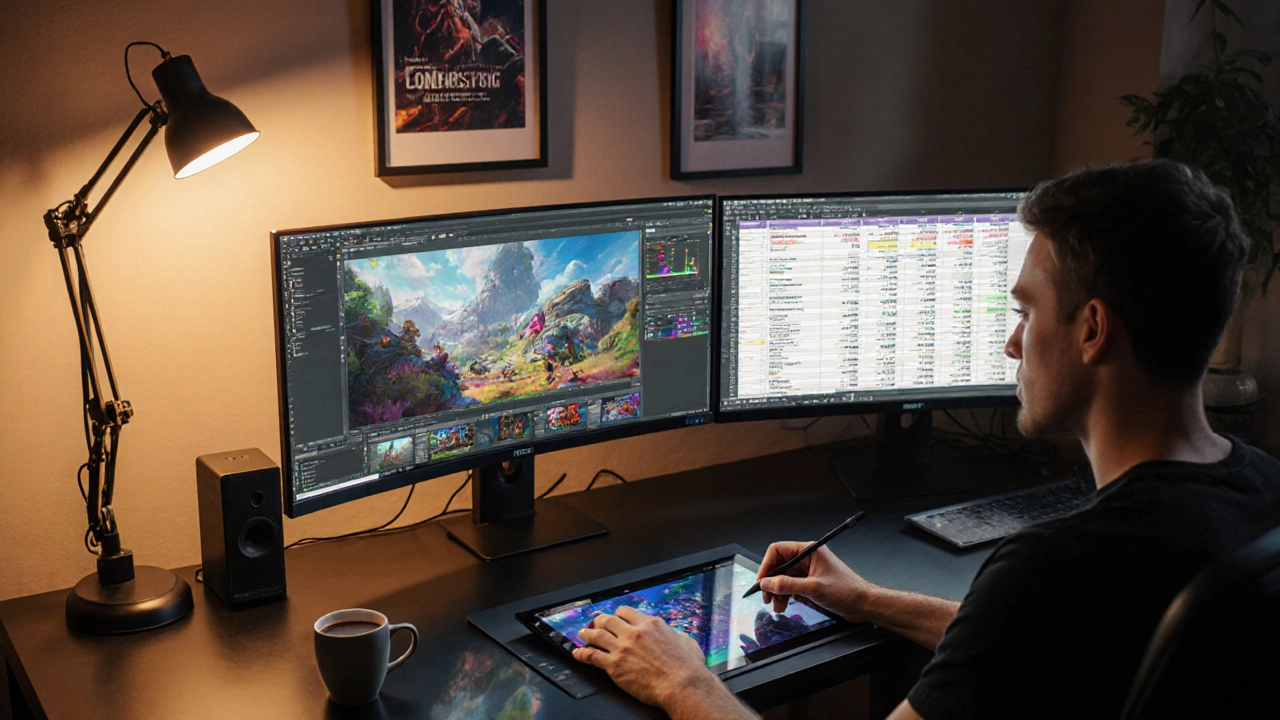Digital Artist Salary Estimator
Your Estimated Annual Income
Freelance Commissions
Clients pay per project for custom work. Income varies significantly based on project scope and client budget.
Stock Art Platforms
Upload assets and earn royalties. Passive income potential but requires consistent volume and trending content.
Full-time Studio Jobs
Regular paycheck from game studios, agencies, or media companies. Stable income with growth potential.
Licensing & Merchandising
Allow companies to use your work for products and earn ongoing royalties.
Key Takeaways
- Full‑time studio jobs usually pay $55,000‑$85,000USD per year, while top freelancers can earn $150,000+.
- Commission work, stock art platforms, licensing, and gaming jobs each have distinct pay ranges and risk levels.
- Skill level, niche focus, location, and business savvy are the biggest earnings drivers.
- Building a strong portfolio, pricing strategically, and diversifying income streams can lift a digital artist’s pay by 30‑50%.
- Understanding taxes and contracts protects earnings and avoids costly mistakes.
When you ask digital artist salary, you’re really wondering whether a career behind a tablet or a mouse can pay the bills, buy a home, or fund a comfortable lifestyle. The short answer: yes, many digital artists earn well, but the picture is patchwork. Income depends on where you work, how you sell your art, and how you manage the business side of things.
What a Digital Artist Actually Does
Digital Artist is a creative professional who produces visual content using software like Photoshop, Procreate, or Blender instead of traditional paints or pencils. They might create concept art for games, illustrations for books, UI assets for apps, or decorative prints for online stores. The role blends artistic skill with technical know‑how, and the end product can be a single illustration, a whole animation reel, or a set of 3‑D models.
Main Income Streams for Digital Artists
In 2025 the market has settled into four reliable money makers:
- Freelance commissions - clients pay per project for custom work.
- Stock art platforms - artists upload assets and earn a royalty each time someone downloads them.
- Full‑time studio jobs - a regular paycheck from a game studio, advertising agency, or media company.
- Licensing and merchandising - you allow companies to print your designs on tees, phone cases, or NFTs and collect a cut.

How Much Each Stream Pays (2025 Data)
| Source | Typical Annual Income | Income Variability | Skill/Experience Needed |
|---|---|---|---|
| Freelance commissions | $40,000‑$120,000 | High (project‑by‑project) | Mid‑level portfolio + client‑management |
| Stock art platforms | $5,000‑$30,000 | Low (passive royalties) | High volume, trend‑aware pieces |
| Full‑time studio job | $55,000‑$85,000 | Low (steady salary) | Specialized skill set (e.g., 3‑D modeling) |
| Licensing & merch | $10,000‑$70,000 | Medium (depends on hits) | Strong brand identity + legal know‑how |
Numbers are averages from surveys by the International Association of Creative Professionals (IACP) and the 2025 Creative Economy Report. Top‑tier freelancers who specialize in concept art for AAA games can push $150,000+ a year, while beginners on stock sites often earn under $1,000.
Factors That Shape Your Paycheck
Even with the same income source, earnings swing wildly based on five key factors:
- Skill level & niche. Artists who master a high‑demand niche (e.g., realistic character design) command higher rates.
- Geographic location. Living in Wellington, NewZealand, you’ll notice salary conversion differences; many studios pay in USD, which can boost local purchasing power.
- Business acumen. Knowing how to write contracts, invoice promptly, and price work correctly prevents under‑payment.
- Portfolio visibility. A well‑curated Portfolio showcases your best pieces, client testimonials, and process breakdowns attracts higher‑budget clients.
- Platform choice. Some stock sites (e.g., Shutterstock) offer 20‑30% royalties, while niche marketplaces (e.g., Gumroad) let you keep 95% of sales after fees.
Boosting Your Earnings: Practical Tips
Here’s a cheat‑sheet you can start using today:
- Specialize early. Pick a style or industry (gaming, children’s books, UI) and become the go‑to artist for that niche.
- Raise rates by 10‑15% after each major client or project milestone. Clients expect incremental price hikes.
- Bundle services. Offer a basic illustration plus two rounds of revisions and a social‑media asset package for a higher total fee.
- Leverage Licensing agreements that let brands use your work in multiple channels for a royalty. Even a modest 5% royalty on a $10,000 product line adds $500 per sale.
- Track every expense and set aside 30% for taxes. In NewZealand the effective tax rate for freelancers can reach 33% if you’re not careful.
- Invest in new software or hardware once a year. Cutting‑edge tools (e.g., AppleVision Pro for 3‑D) let you charge premium rates.

Common Pitfalls and How to Avoid Them
Many artists stumble over the business side, not the art itself. Watch out for these traps:
- Undervaluing work. Saying “I’ll do it for free to build my portfolio” can set a low‑price precedent.
- Vague contracts. Missing clauses on revisions, usage rights, and payment schedule leads to endless back‑and‑forth.
- Relying on a single income source. If a major client pauses, your cash flow dries up.
- Ignoring tax obligations. Late filing penalties can eat 10‑15% of your earnings.
- Burnout. Working 80‑hour weeks without breaks lowers quality and reduces future demand.
Use a simple contract template (available from the NewZealand Graphic Designers Association) and always ask for a deposit before starting work.
Bottom Line: Are Digital Artists Paid Well?
Answering the original question depends on your definition of “well.” If you aim for a steady six‑figure income, you’ll need a mix of high‑paying studio work, selective freelance commissions, and passive licensing revenue. For most mid‑level artists, a realistic target in 2025 is $50,000‑$80,000USD after taxes, which translates to a comfortable lifestyle in many countries, including NewZealand.
The good news is that the digital art market continues to grow-AI‑generated art tools have actually increased demand for human‑crafted assets that convey emotion and originality. By treating your art as a business, diversifying income, and staying up‑to‑date with industry trends, you can turn a passion into a well‑paid career.
Frequently Asked Questions
What is the average hourly rate for a freelance digital artist?
In 2025 the median hourly rate sits around $40‑$65USD, but specialists in game concept art or motion graphics can charge $100‑$150 per hour.
Do stock art platforms provide a reliable income?
They offer passive income, but most artists earn less than $30,000 per year unless they upload hundreds of high‑quality, trend‑aligned assets.
How much can a full‑time digital artist earn in NewZealand?
A senior UI/UX artist at a Wellington studio typically makes NZ$95,000‑$120,000 annually, which is roughly $55,000‑$70,000USD after conversion.
What legal steps should I take before licensing my artwork?
Register your work with a copyright office, draft a clear licensing agreement stating territory, duration, and royalty percentage, and consider consulting a lawyer familiar with creative contracts.
Can I combine multiple income streams without overworking?
Yes-use time‑blocking. Reserve weekdays for client work, schedule a few hours on weekends for stock uploads, and automate licensing royalties. Balancing prevents burnout while keeping cash flow steady.

